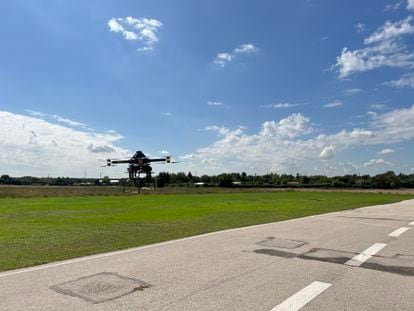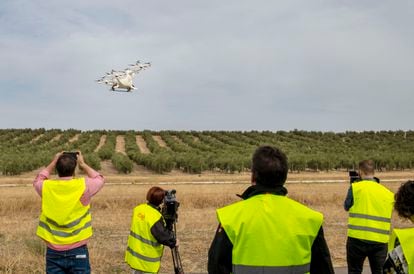Flying cars have starred in numerous science fiction films in recent decades, showing a future that never came. However, the conquest of the urban sky now seems closer: the public company Ineco just launched a study group —Siam Cluster— to work on air mobility in cities, while different companies carry out transport tests with drones in Zaragoza, A Coruña or Jaén. In the absence of a specific European regulation (expected in 2025), the sector believes that the delivery of medicines with drones to rural areas could begin in two years and be extended later to the distribution of urban goods. Paris wants flying taxis at the Olympics this summer, although the spread of air taxis will not reach Europe until at least 2030.
“The drones eVtol [acrónimo en inglés de “eléctrico de despegue y aterrizaje vertical”] They are a new type of devices that are usually larger than the drones we are used to seeing, and can carry goods and even people. They are zero-emission electric vehicles that take off vertically, so they need less space,” explains Sergio Vázquez, president of Ineco. Isabel Buatas, president of the Siam Cluster, adds: “These drones are going to transform cities, because a new layer of the sky will be used, and although technically it would be possible to start using them, there is still a great challenge ahead in terms of regulation, integration in airspace, telecommunications…”.
For now, there is legislation for the simplest drones—remotely controlled and with a short range—but the European Commission is developing regulations for new devices, which can fly in automatic mode with cargo, or with a pilot and passengers. “eVtol drones and air taxis will have a European regulation, which will define their type of construction, how they must operate and what training the pilots will need,” explains Daniel García-Monteavaro, head of drone development at Enaire, the entity in charge of managing air navigation in Spain. “Manufacturers are already working with the European Aviation Safety Agency (EASA) to have references and work on the future certification of their vehicles, although until the future regulation arrives they will not be able to certify them with a stable regulatory framework,” he continues. Afterwards, municipal regulation will also be needed, which Zaragoza and Madrid are already beginning to study.

While it arrives, several Spanish companies are testing new prototypes. “We have developed an eVtol capable of carrying six people on board, or 500 kilos of cargo, with a flight range of 130 kilometers,” says Óscar Lara, Director of Operations at Crisalion Mobility. “The model is based on batteries that already exist and can be mass produced, but the kilometer range will increase as the batteries improve,” he continues. They have already tested their air taxi prototype – called Concept Integrity – on test flights in Jaén and Lugo.
Information is the first tool against climate change. Subscribe to it.
Subscribe
Bluenest, from the Spanish company Globalvia —integrated into SIAM—, works in vertiports, the places where these vehicles will have to take off and land. “They need much less space than a heliport, because these electric vehicles have a purely vertical takeoff. And they can be of various types, from a fenced space on the ground two to five meters wide for light cargo drones, to another of about 20 meters to transport people. We are even developing lockers to deliver packages that can be installed in urban areas or hospitals with a landing surface of one meter,” explains José Ignacio Rodríguez, manager of Bluenest. The company is already testing health logistics in Madrid and with 600 kilo air taxis – also in Jaén and Lugo – and they have projects in the Canary Islands and Zaragoza.
Precisely in the Aragonese capital, the City Council enabled an area near the AVE station to carry out tests with these vehicles. “Our vertiport has already been the scene of different collaboration experiences with public and private institutions, it is a strategic commitment of the city,” says the mayor, Natalia Chueca. One of them is the pharmaceutical distributor Novaltia: “The distribution of medicines in Aragon is complex, we travel 17,000 kilometers a day in vans, sometimes to reach small towns. We are already testing 25 kilo drones (including cargo) that could carry medicines to vertiports in these towns, installing several bases: for example, Jaca for the Pyrenees, Teruel for the towns in the area…”, says Fernando Castillo, general director. from Novantia.

The company would already have the technical capacity to launch the project, but they need the new authorization from the EASA, as well as certify their vehicles. “And that we be authorized to have health corridors to fly in certain areas. I hope we can start in 2026″, adventure. All sources are confident that health applications will be the first we see in progress: urgent delivery of medicines, transfer of blood or medical tests… Above all, in rural environments or sparsely populated urban areas, which are difficult to reach quickly. In fact, the La Paz Hospital has already carried out a trial with drones carrying a load of medicines at its headquarters in Cantoblanco.
Urgent delivery of medicines
“The healthcare part is going to develop faster due to social acceptance and because it has a very direct use: a drone can deliver medicine very quickly and without traffic jams. We have developed a locker in which an eVtol can land and can be easily installed in any hospital or medical center,” says Enrique Ventas, from the Technical Institute of Galicia (ITG), also a member of the Siam Cluster. In fact, Ineco estimates that up to 70% of the time can be saved in a medical delivery, the most urgent ones. “The development will be gradual, first in remote towns, then in the peri-urban area and later in the center of the cities. We are not going to suddenly see 1,000 drones flying, but they will begin to be more common,” he continues. They have an urban testing vertiport in A Coruña.

The logistics sector has high hopes for this modality. “The urban distribution of goods has been greatly promoted after the pandemic, very quickly and not always sustainable. We have had to expedite all our future plans. Urban aerial freight distribution was in the pipeline to be developed later, but is now accelerating. And it can be a reality in 2030,” ventures Francisco Aranda, president of the UNO logistics association, which will be integrated into SIAM. Vázquez, from Ineco, believes it is a great opportunity: “The great mobility debate now is the use of public space, collapsed by private and delivery vehicles, while eVtol drones will move through another layer of space, freeing up space public of the streets.”
/cloudfront-eu-central-1.images.arcpublishing.com/prisa/525HPZ7WWZFV3L5LNE7RPGIYUU.jpg)
There are also risks, such as privacy (because there may be drones flying at the height of tall buildings), people's fear of a drone falling on them and, related to all this, social acceptance, which is always complex at the beginning. European legislation is advancing more slowly because it does not want to have to face an accident that paralyzes development, while in countries like China or the Gulf emirates there are already more advanced experiences even with air taxis.
In Europe, these types of vehicles with passengers – like those tested by Crisalion in Spain – will arrive later, but tests are already being carried out. “The CitiAirbus NetxGen model has four seats and can fly at 120 kilometers per hour with a range of 80 kilometers. It is designed to be piloted and combines wings with propellers to optimize performance. The inaugural flight will take place this year,” explains Balkiz Sariah, CEO of the company. In the absence of generalization, Paris has announced that it will launch a limited air taxi service —called VoloTaxi— during the Olympic Games it will host this summer.

“At first they will have a higher cost, so they could be used as a tourist service, or to get from the airport to somewhere in the center in a few minutes,” says Buatas, from Siam. García-Monteavaro, from Enaire, third: “The Balearic Islands want to test a flight between Mallorca and Menorca, with a large drone that simulates an air taxi.” Other uses at the beginning may be for tourism, although for this it will be necessary to designate urban air corridors, and also distribution to remote towns. Vázquez, from Ineco, summarizes: “In 10 years the main image of a city will change, because there will be a new air mobility that we will have to get used to. It doesn't mean that the sky will be full of vehicles, but it does mean that there will be new traffic. For the first time, the horizon is close.”
You can follow Climate and Environment in Facebook and xor sign up here to receive our weekly newsletter
Subscribe to continue reading
Read without limits
_
#Aerotaxis #delivery #goods #drones #vertiports.. #Urban #air #mobility #arrives #sooner #imagine